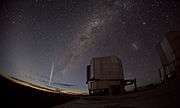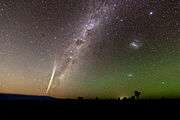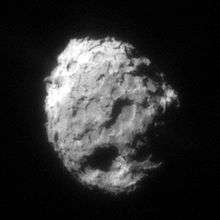C/2011 W3 (Lovejoy)
|
Comet Lovejoy photographed by Dan Burbank aboard the ISS, 21 December 2011 | |
| Discovery | |
|---|---|
| Discovered by | Terry Lovejoy |
| Discovery date | 27 November 2011 |
| Orbital characteristics A | |
| Epoch |
JD 2455901.5 (6 December 2011) |
| Aphelion | 157.36 ± 0.50 AU |
| Perihelion | 0.00555 AU |
| Semi-major axis | 78.68 ± 0.25 AU |
| Eccentricity | 0.99993 |
| Orbital period | ~622 a (epoch 2050)[1] |
| Inclination | 134.36 ± 0.002° |
| Last perihelion | 16 December 2011 |
| Next perihelion | c. 2633?[1] |
Comet Lovejoy, formally designated C/2011 W3 (Lovejoy), is a long-period comet and Kreutz Sungrazer. It was discovered in November 2011 by Australian amateur astronomer Terry Lovejoy. The comet's perihelion took it through the Sun's corona on 16 December 2011, after which it emerged intact, though greatly impacted by the event.
As Comet Lovejoy was announced on the 16th anniversary of the SOHO satellite's launch it became known as "The Great Birthday Comet of 2011", and because it was visible from Earth during the Christmas holiday it was also nicknamed "The Great Christmas Comet of 2011".[2][3]
Discovery
Comet Lovejoy was discovered on 27 November 2011 by Terry Lovejoy of Thornlands, Queensland, during a comet survey using a 20 cm (7.9 in) Schmidt–Cassegrain telescope and a QHY9 CCD camera.[4] It is the third comet discovered by Terry Lovejoy. He reported that it was "a rapidly moving fuzzy object" of 13th magnitude, and additional observations were made by him over the next couple of nights.[4][5]
Independent confirmation of the comet did not come until 1 December, when it was observed by Alan Gilmore and Pamela Kilmartin at the Mount John University Observatory in New Zealand, using its 100 cm (39 in) McLellan Telescope. Upon confirmation, an official report was made to the Central Bureau for Astronomical Telegrams, and the comet's existence was announced by the Minor Planet Center on 2 December.[4] It is the first Kreutz-group comet discovered by ground-based observation in 40 years.[6]
Observations
The first orbital elements using an assumed parabolic trajectory were published by Gareth Williams of the Minor Planet Center on 2 December, with an estimated perihelion of 0.0059 AU occurring near midnight UTC of 15/16 December. Further refinements were published during subsequent days, including one on 5 December, estimating perihelion at 0.0056 AU just before midnight on 15 December. On 11 December the first elliptical orbit was published, estimating perihelion at 0.0055 AU just after midnight on 16 December.[4][7]
In space, the comet first became visible to the STEREO-A spacecraft on 3 December, and to the SOHO spacecraft on 14 December. As the comet approached the Sun it was observed by eighteen instruments on six satellites: STEREO-A and -B, SOHO, SDO, Hinode and PROBA2.[8][9]
A small companion comet was detected in SOHO images on 14 December by Zhijian Xu, and later spotted by the twin STEREO spacecraft.[2][10] It is believed to be a fragment of Comet Lovejoy that broke away several decades ago. This discovery was not unexpected, as Kreutz-group comets are often found with smaller companions.[2][11]
At its brightest, Comet Lovejoy had an apparent magnitude of between –3 and –4, which is about as bright as the planet Venus.[8][12] It is the brightest sungrazing comet ever observed by SOHO, and the brightest comet to appear since Comet McNaught of 2007, which shone at visual magnitude –5.5.[2][13] Nevertheless, Lovejoy was largely invisible to the naked eye during its peak brightness due to its proximity to the Sun.[3][11]
Perihelion
Comet Lovejoy reached perihelion on 16 December 2011 at 00:17 UTC, as it passed approximately 140,000 kilometres (87,000 mi) above the Sun's surface[14][15] at a speed of 536 km/s (333 mi/s), or 0.18% the speed of light.[16] It was not expected to survive the encounter due to extreme conditions in the corona, such as temperatures reaching more than one million kelvins and the exposure time of nearly an hour. However, the Solar Dynamics Observatory (SDO), as well as other Sun-monitoring spacecraft, observed the comet emerge from the corona intact.[17][18][19] The STEREO and SOHO spacecraft continued to observe the comet as it moved away from the Sun.[19]
Before perihelion, the nucleus of Comet Lovejoy had been estimated to be between 100 and 200 metres (330 and 660 ft) in diameter. Since the comet survived perihelion, it is thought that the nucleus must have been larger, perhaps up to 500 metres (1,600 ft).[20] During the coronal passage, it is believed that a significant fraction of the comet's mass was burned off.[19]
Outbound flight
The first ground-based observation of Comet Lovejoy post-perihelion occurred on 16 December at 19:55 UTC, when it was seen by Rick Baldridge and Brian Day of the Foothill Observatory. Baldridge estimated the comet at magnitude −1.[4] The comet's discoverer, Terry Lovejoy, made a pair of observations on 17 December at 01:12 and 20:24 UTC, with apparent magnitudes estimated at −1.2 and −0.8, respectively.[4]
Images taken on 20 December around 08:00 UTC suggested that the comet had undergone significant changes. Taken by Czech astronomer Jakub Černý using the robotic FRAM telescope at Pierre Auger Observatory, the images indicated that "the nucleus had apparently become bar-shaped and was accompanied by a bright tail ray."[4][21]
Comet Lovejoy re-emerged as a naked eye object in the Southern Hemisphere around 21–22 December,[22] when astronaut Dan Burbank photographed it from the International Space Station.[23][24] Ground-based photographers continued to capture images of the comet, which had dimmed to around 4th magnitude.[23] While Lovejoy would have continued to be visible to Southern Hemisphere observers into early 2012, large telescopes would have been required to see the comet by the time it crossed into the Northern Hemisphere in February.[3]
Some concern was expressed after perihelion that the stresses induced in the comet by its close approach to the Sun might result in its disintegration.[8] That observers were unable to locate a distinct nucleus amidst the more visible tail furthered this idea;[3] using observations from the Pierre Auger Observatory, Zdeněk Sekanina and Paul Chodas determined that, while the nucleus did survive perihelion for several days, following a significant outburst of dust on 19 December, the nucleus underwent a "cataclysmic fragmentation" event on 20 December and completely disappeared.[25]
In the event that some portion of the nucleus did survive, the eccentricity and inclination of Comet Lovejoy's orbit avoids significant perturbation from planets, which leaves the possibility that the comet may return for another perihelion.[8] Using an epoch 2050 solution, Comet Lovejoy is estimated to have about a 622-year orbit and a return to perihelion around the year 2633.[1]
Possible fragmentation history
An elliptical orbit calculated by Sekanina and Chodas in 2012 indicates that Comet Lovejoy is a fragment of an unrecorded sungrazer that reached perihelion around 1329. The fragmentation history suggested by these authors is that a parent sungrazer, likely the comet observed in 467 CE, split near the Sun due to tidal forces during its pass. The principal fragment – or a non-tidally fragmented portion of it – returned as the Great Comet of 1106, but a secondary fragment was imparted a longer orbital period and returned about 1329. This secondary also split at perihelion and its principal fragment will return around 2200, likely as a cluster of further fragments. A secondary fragment of this event left on a shorter period that theoretically should bring it back to the inner solar system during the early years of the 21st century. At some point after perihelion, this secondary fragment broke apart due to non-tidal forces and one of the resulting fragments became Comet Lovejoy. Other similar fragments may also exist and might return as sungrazers in the near future.[25]
Gallery
|
References
- 1 2 3 Horizons output. "Barycentric Osculating Orbital Elements for Comet C/2011 W3 (Lovejoy)". Retrieved 7 August 2012. Solution uses the Solar System barycenter and barycentric coordinates (select Ephemeris Type:Elements and Center:@0). Saved Horizons output file generated 7 August 2012.
- 1 2 3 4 Battams, Karl (2 December 2011). "The Great "Birthday Comet" of 2011, Chapter 1: Inbound". Sungrazing Comets. Navy.mil. Retrieved 28 December 2011.
- 1 2 3 4 Hoffman, Tony (27 December 2011). "Comet Lovejoy's Surprising Path to Greatness". PC Magazine. Retrieved 28 December 2011.
- 1 2 3 4 5 6 7 Kronk, Gary W. "C/2011 W3 (Lovejoy)". Cometography.com. Retrieved 28 December 2011.
- ↑ Beatty, Kelly (6 December 2011). "Comet Lovejoy's Date With Destiny". Sky & Telescope. Retrieved 28 December 2011.
- ↑ Bauer, Markus (14 December 2011). "The beginning of the end for comet Lovejoy". ESA.int. Retrieved 29 December 2011.
- ↑ Williams, Gareth V (11 December 2011). "MPEC 2011-X36 : COMET C/2011 W3 (LOVEJOY)". Minor Planet Center. Retrieved 29 December 2011.
- ↑ "The Great "Birthday Comet" of 2011". SOHO. NASA.gov. 15 December 2011. Retrieved 28 December 2011.
- ↑ Battams, Karl (December 2011). "SOHO-LASCO Comet Reports for 201112". Sungrazing Comets. Navy.mil. Retrieved 28 December 2011.
- 1 2 O'Neill, Ian (15 December 2011). "Comet Lovejoy to 'Play Chicken' With the Sun". Discovery.com. Retrieved 28 December 2011.
- ↑ Phillips, Tony (15 December 2011). "What's Up in Space". Spaceweather.com. Retrieved 28 December 2011.
- ↑ "Brightest comets seen since 1935". International Comet Quarterly. 12 February 2009. Archived from the original on 28 December 2011. Retrieved 28 December 2011.
- ↑ "C/2011 W3 (Lovejoy)". JPL Small-Body Database Browser. NASA.gov. 4 June 2012. Archived from the original on 5 August 2012.
- ↑ Malik, Tariq (16 December 2011). "Sun Rips Tail From Comet During Solar Close Encounter". Space.com. Retrieved 28 December 2011.
- ↑ Battams, Karl (25 February 2013). "Did you know". Twitter.com. Retrieved 25 June 2013.
- ↑ Wall, Mike (15 December 2011). "Satellites to Watch Comet's Death Plunge Through Sun Today". Space.com. Retrieved 28 December 2011.
- ↑ Wall, Mike (15 December 2011). "Comet Lovejoy Survives Fiery Plunge Through Sun, NASA Says". Space.com. Retrieved 28 December 2011.
- 1 2 3 Phillips, Tony (16 December 2011). "Comet Lovejoy Plunges into the Sun and Survives". Science News. NASA.gov. Retrieved 28 December 2011.
- ↑ Phillips, Tony (12 January 2012). "Some Comets like it Hot". Science News. NASA.gov. Retrieved 14 January 2012.
- ↑ Černý, Jakub (19 December 2011). "První snímky komety Lovejoy ze Země" [First images of Comet Lovejoy from the Earth]. Kommet.cz (in Czech). Retrieved 8 January 2012.
- ↑ Cain, Fraser (21 December 2011). "Timelapse of Comet Lovejoy Rising by Colin Legg". Universetoday.com. Retrieved 28 December 2011.
- 1 2 Beatty, Kelly (22 December 2011). "Comet Lovejoy Keeps on Giving". Sky & Telescope. Retrieved 28 December 2011.
- ↑ Kauderer, Amiko (23 December 2011). "International Space Station Imagery: ISS030-E-015479". NASA.gov. Retrieved 28 December 2011.
- 1 2 Sekanina, Zdeněk; Chodas, Paul W (October 2012). "Comet C/2011 W3 (Lovejoy): Orbit Determination, Outbursts, Disintegration of Nucleus, Dust-Tail Morphology, and Relationship to New Cluster of Bright Sungrazers". The Astrophysical Journal. 757 (2). arXiv:1205.5839
 . Bibcode:2012ApJ...757..127S. doi:10.1088/0004-637X/757/2/127.
. Bibcode:2012ApJ...757..127S. doi:10.1088/0004-637X/757/2/127.
Further reading
- Gundlach, Bastian; Blum, Jürgen; Skorov, Yuri V; Keller, Horst U (2012). "A note on the survival of the sungrazing comet C/2011 W3 (Lovejoy) within the Roche limit". arXiv:1203.1808v2
 [astro-ph.EP].
[astro-ph.EP]. - Knight, M M; Weaver, H A; Fernandez, Y R; Chesley, S R; et al. (16–20 May 2012). "A Multiwavelength Investigation of the Remains of Sungrazing Comet Lovejoy (C/2011 W3)". Asteroids, Comets, Meteors. Niigata, Japan: Lunar and Planetary Institute. Bibcode:2012LPICo1667.6409K.
External links
| Wikimedia Commons has media related to C/2011 W3 (Lovejoy). |
- C
/2011 W3 at the JPL Small-Body Database Browser - C
/2011 W3 at the Minor Planet Center - C
/2011 W3 on Cometography.com - How did Comet C
/2006P1 (McNaught) and C (Terry Lovejoy on Facebook)/2011 W3 (Lovejoy) compare? - EUV and X-Ray Observations of Comet Lovejoy (C
/2011 W3) in the Lower Corona (arXiv:1304.1544 / 4 Apr 2013)
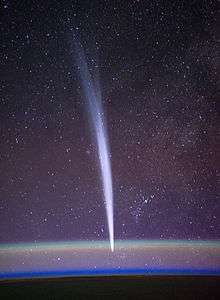
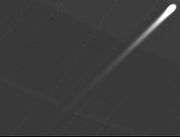

.gif)
